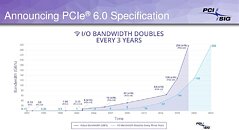Thursday, November 5th 2020
PCIe 6.0 Specification Reaches Milestone, Remains on Track for a 2021 Release
PCI-SIG has recently confirmed that version 0.7 of the PCIe 6.0 Specification has been officially released to its members. The PCI-SIG organization has already ratified the PCIe 5.0 standard and plans to release the full PCIe 6.0 specification in 2021. PCIe 6.0 will bring the same doubling in data rates seen with previous generations of the standard including a 2x improvement over PCIe 5.0, 4x boost over PCIe 4.0, and an 8x increase in speeds over the common PCIe 3.0 standard.
The organization has been speeding up its timeline for new versions of the PCIe specification with PCIe 3.0 being released in 2010 followed by PCIe 4.0 in 2017, PCIe 5.0 in 2019, and with PCIe 6.0 expected in 2021. The PCIe 6.0 standard is designed to fulfill the needs of future devices in the PC and enterprise markets such as 800 Gb/s Ethernet cards. The earliest we can expect to see PCIe 6.0 devices in the PC market would be 2023 or 2024 depending on requirements.
Source:
PCI-SIG
The organization has been speeding up its timeline for new versions of the PCIe specification with PCIe 3.0 being released in 2010 followed by PCIe 4.0 in 2017, PCIe 5.0 in 2019, and with PCIe 6.0 expected in 2021. The PCIe 6.0 standard is designed to fulfill the needs of future devices in the PC and enterprise markets such as 800 Gb/s Ethernet cards. The earliest we can expect to see PCIe 6.0 devices in the PC market would be 2023 or 2024 depending on requirements.



29 Comments on PCIe 6.0 Specification Reaches Milestone, Remains on Track for a 2021 Release
Hey Industry pundits:
DING DING DING!! This is your 2020 wake up call, let's work on things that actually NEED work and updating. SATA specs for example. Seriously, get on it!
Just by supporting PCIe4 prices shot up. Image how high will they go when pcie6 comes into play.
That they will go for doubling speed again was pretty much a given, but some info on how they plan to achieve it (QAM?) would have been appreciated.
Edit: Ok, the slide says PAM-4. Yeah that's actually feasible, more clock seemed kind of improbable.
Frequencies will be raised, it can work on SoC level also on interposer, the future lies there creating a stacked combos. We are not limited to classic motherboards on FR4. PCIe is everywhere actually. Is it a mobile phone or router or any other device having a SoC...
So basically, if you don't need it, that's your issue for not grasping the whole picture.
SSDs are meant to be connected via PCIe, as it allows using protocol optimized for them (NVMe).
There's no point in maintaining and improving old tech when there's a better one already.
PCIe 4.0 preliminary spec was in 2011 and final spec announced in June 2017. Same dates for PCIe 5.0 are June 2017 and May 2019.
For PCIe 6.0 preliminary spec was in June 2019 and this news is just the next version of it (updates are electrical spec and test chips data AFAIK). If it keeps being on track, the spec should be finalized in summer 2021.
When actual implementations in hardware happen is a different topic. Usually the first controllers or implementations take a few months to half a year from final spec.
Desktop and x86 CPUs will take longer, usually having to wait for a new platform generation. Whether or not newer versions are worth it for desktop is a matter of discussion and arguments for the foreseeable future, speed upgrades are awesome but the cost and complexity increases are also significant this time around.
AMD would definitely push it; given that their future vision for the Infinity Architecture partially scales with PCIe (more bandwidth for total heterogeneous computing), and given that their Zen archs are mostly uniform from the top-down. There's also the fact that AMD said they would pursue the leading edge, so it's likely that they will adopt it as soon as possible.
Intel would push it more to either try and remain ahead somewhere (like their original plan to skip PCIe 4.0 for 5.0 in 2020 before delays), or just to stay in sync with AMD given the bit of marketing brouhah that Ampere 4.0 marketing gave Intel and Intel mobo-makers, as well as in the highly competitive enterprise sector.
On the other end, with AMD having lit a fire under PCIe device makers towards faster components after pushing PCIe 4.0 into mainstream, and Intel supposedly aiming for mainstream PCIe 5.0 mid-late 2021 with AMD following late-2021 or early-2022, it wouldn't be all that surprising either if PCIe controllers continue to race towards PCIe 6.0 capability (instead of settling into a lull like during the PCIe 3.0 period). I feel though, that PCIe 6.0 will become the mainstay like PCIe 3.0 was. It'll take quite some time for tech to catch up to those speeds.
The reason for stopping the development of even more powerful and productive mainstream components is that no one will need them. The latest models(in 2025) will be enough to meet all "home" consumer needs. And the prices of development and, respectively, the selling prices of the components after 2025 would be completely different from the usual ones for the mainstream.
I haven't used the "M.2" term - I've referred to PCIe as an interface. PCIe itself is flexible and fast enough to allow using single (x1) link for SSDs, and already be faster than SATA.
The tech is ready - there's simply no such connector to utilize only a singular lane.
And I think that's because there's no demand for it - either someone is fine with SATA limitations, or wants something much more, what requires more lanes (M.2 PCIe).
Some kind of a stop-gap may be using PCIe x1->M.2 adapters. Faster than SATA? Check. Have a free connector for it? Check... in most cases.It may happen if you consider vertical M.2 connectors ;)Old tech doesn't mean "useless". I have no idea where you got that from.You may want to read SATA-IO FAQ. Mentions why there's no speed bump and what are the goals for SATA specs now.
While I do think that NVMe M.2 has replaced SATA as a boot drive bus but as a general storage PC bus, SATA is far from being replaced especially since much of legacy hardware is still supported. Though sooner or later, USB will eventually replace SATA once the software department could no longer support legacy systems.
A great example is the Radeon Pro 5600m in my laptop. It's only connected with 8 PCIe lanes at 3.0. Imagine if you only needed two lanes to do the same thing. Or even if you don't have wide adoption, what if Intel or AMD used it as the interconnect to their chipset/PCH. Then it starts sounding like a much better PCIe switch if it's 4 lanes to 20 lanes. It's just progress and there is nothing wrong with progress.
Edit: Also, you need a spec before you can implement it. This stuff takes time and doesn't happen overnight.